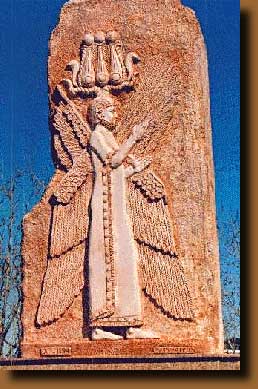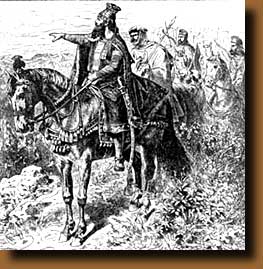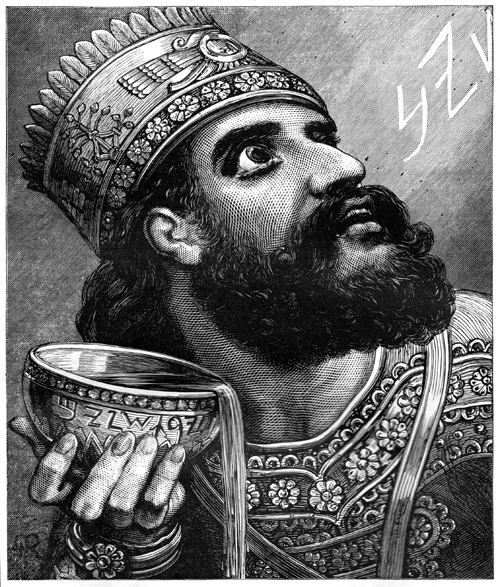
Forces Engaged
Persian: Possibly 50,000. Commander: Cyrus II, the Great.
Lydian: Unknown, but probably more than those of Persia. Commander: Croesus.
Importance
Cyrus’s victory gave him control of the vast wealth of Lydia and
denied Babylon a strong ally. From this victory, Cyrus challenged and
won the Neo-Babylonian throne, establishing the Persian Empire.
Historical Setting
In 612 b.c., the Assyrian Empire, which had dominated and terrorized
the land from the Persian Gulf to the Mediterranean since the middle of
the eighth century, was overthrown. In that year, two subservient
populations, the Babylonians and the Medes, joined forces and captured
the Assyrian capital of Nineveh. In the wake of that victory, the
empire was divided between the victors: Nabopolassar of Babylon ruled
the southern half, and Cyarxes of Media ruled the northern. Media was
originally the region that today encompasses northwestern Iran along
the southern bank of the Caspian Sea into Armenia. Under Cyarxes,
Median power was stretched westward to the frontiers of Asia Minor and
eastward almost to Afghanistan. Cyarxes died in 585 b.c., the year that
he and the kingdom of Lydia in Asia Minor agreed that the border
between their territories would be the Halys River. Cyarxes was
succeeded by Astyages, who apparently was quite a tyrant and who
alienated the Median aristocracy by depending on religious advisors for
his policy formulation.
In 580 b.c., Astyages’s daughter gave birth to a son, named Cyrus.
Legend has it that Astyages dreamed that this grandson would overthrow
him, and Astyages ordered his death, but Cyrus was saved in a fashion
virtually identical to that of Moses in Egypt. Whatever the exact
details, Cyrus lived in the region called Persis (Persia), which today
would lie in southwestern Iran near the Persian Gulf coast. The Greek
historian Herodotus claimed that in 553 Cyrus was approached by
Harpagos, sometime commander of the Median army, asking that Cyrus
begin a rebellion against Astyages; if he would do so, the Median
aristocracy would support it. The length of the rebellion is difficult
to determine because sources from the time (and soon thereafter) vary
considerably. Probably it went on for 4 years until the battle at
Pasargadai (the capital of Persis), when Harpagos defected to Cyrus.
Allying himself with the Scythians and Hyrcanians (from the southern
Caucasus), Cyrus captured the Median capital of Ecbatana during 550–549.
Cyrus immediately gained the confidence of not only the Median
aristocracy but almost all of Astyages’s former subjects because Cyrus
went to great lengths to show himself a just and merciful conqueror.
Many of the Median military leaders received high command positions in
the Persian army. While Cyrus consolidated his throne, trouble was
brewing on his western frontier. The King of Lydia, Croesus, was the
son of Alyattes, who had established with Cyarxes the Halys River as
the border between Lydia and Media. Croesus apparently had had good
relations with Astyages and viewed Cyrus with alarm. Croesus began
developing alliances with Egypt, Babylon, and Sparta. Lydia was well
known for its superior cavalry, and with all those extra troops it
could prove a serious threat to Cyrus’s new realm. While visiting
Gubaru, future satrap of Susa in Elam, Cyrus learned that Croesus had
led troops across the Halys into the province of Cappadocia and was
pillaging the countryside. Cyrus gathered his forces and marched west
in the spring of 547. His army marched along the Median-Babylonian
frontier, crossed the Tigris River at Arbela (site of a later victory
by Alexander the Great), picked up some reinforcements from Armenia and
Kurdistan, and descended into the Cappadocian plain late in 547.
The Battle
The two armies met near the town of Pteria and fought a hard but
inconclusive battle at the beginning of winter. No details are
available, other than there was no clear winner. As the Cappadocian
plain had been stripped of resources during the Lydian occupation,
Croesus decided it was best to withdraw to his capital at Sardis. After
wintering there, he would regather his forces, supplemented by those of
his allies, and resume the war in the spring. When he reached Sardis,
Croesus dismissed his Greek mercenary troops and sent messages to his
allies, detailing his military needs for the next season’s campaign.
Cyrus met with his advisors after the battle and received much the
same counsel: go home for the winter and start up again next spring.
Here, however, Cyrus showed his first flashes of genius. Sure that
Croesus would not want to keep his mercenaries on the payroll during
the winter, and that Lydia’s allies could not possibly dispatch
reinforcements for a few months, Cyrus decided to follow Croesus to
Sardis. After waiting sufficient time for Croesus to get home and
dismiss his forces, Cyrus launched a forced march through Anatolia.
Croesus heard a rumor of Cyrus’s approach but put no stock in it.
Indeed, not until the Persian forces appeared at the city gates did
Croesus believe what was happening.
In spite of what Cyrus had supposed, Croesus was able to call up a
large army. How large is unknown, but it almost certainly was
significantly more than the Persians. Xenophon gives Cyrus’s strength
as 200,000, but it was probably somewhere between 20,000 and 50,000.
The two forces met just outside Sardis on the Plain of Thymbra early in
546. Cyrus placed his army in square, with flanking cavalry and chariot
units set back. The Lydians deployed in the traditional formation of
long parallel lines. The battle opened with the Lydian cavalry
attempting to envelop the square. As they advanced, the enveloping
units moved ahead of the center, leaving gaps in the Lydian line. Here
Cyrus deployed his secret weapon. At Pteria, one of his generals had
noticed the way in which Lydian horses had shied at the presence of
Persian camels used for transport. Cyrus formed his pack animals into
the first camel corps in history and sent them forward. Catching the
smell of the camels, the Lydian horses panicked.
The cavalry dismounted and attempted to fight on foot, but their
lances proved too unwieldy to be effective. Inside Cyrus’s square
formation, his archers launched volley after volley of arrows into the
Lydian ranks, further disorganizing them. Cyrus’s infantry and chariots
on the flanks charged into the dismounted Lydian cavalry, and then,
with the gaps on either side of the Lydian center wide open, Cyrus sent
his cavalry through them. The result was a rout, as Lydian survivors
ran for the walls of Sardis. Persian forces immediately surrounded the
city and besieged it for 14 days. Learning of a possible weak point in
the defenses—where the city’s walls met and melted into a cliff—Cyrus
sent a small force up the hill and onto the walls, which at that point
overlooked the citadel; his troops quickly captured it and Croesus. The
city opened its gates to Cyrus the following morning. From this point,
Lydia ceased to exist as an independent kingdom.
Results
Although Cyrus’s victory over Croesus came in 546 b.c., 7 years
before his conquest of Babylon, the victory at Thymbra marked the
turning point in Cyrus’s campaign to establish a Persian Empire.
Babylon, as co-inheritor of the Assyrian Empire, was a natural rival,
in spite of the fact that they had done little to provoke Cyrus.
The Babylonian King Nabonidus was in the midst of his own internal
crisis. Although intent on maintaining strong trade routes between the
Persian Gulf and the Mediterranean, which would of course continue to
enrich the wealthiest of ancient cities, Nabonidus provoked his
population over religious matters. He had come to power from his
position as a general, rather than through birth. Thus, he distrusted
the Babylonian establishment. He preferred the worship of Sin, the moon
goddess, over Marduk, the Babylonian national deity. He established
temples to Sin in Babylon, a direct affront to the people. In response
to a dream, Nabonidus marched the army to the city of Harran to
reestablish the Temple of Sin there. He then spent 7 years campaigning
in Arabia, capturing territory as far as Yathrib (Medina). He colonized
a string of oases through Arabia, although it is unclear if this was
for military or trade purposes. This expedition also alienated the
Babylonians because the king was supposed to be in attendance at the
New Year’s festivals, and Nabonidus missed seven in a row. His son and
regent, Balshazzar, oversaw the business of government. When, after
extending his power far to the east in campaigns up to Bactria (modern
Afghanistan), Cyrus turned toward Babylon, Nabonidus finally tried to
appease his subjects and defend his land. He sent for all the idols of
Marduk to be collected in Babylon to strengthen its spiritual defenses.
But apparently it was too late. Cyrus seems to have been in contact
with the religious leaders in Babylon, assuring them of his religious
tolerance, and thus fomenting a resistance movement in Nabonidus’s
backyard.
There are two completely different accounts of the fall of Babylon
to Cyrus. In September 539 b.c., Cyrus and his army defeated the
Babylonians at Opis, the former capital of Akkadia, which city he
proceeded to destroy. On 10 October, the town of Sippar surrendered
without a struggle. Hearing this, Nabonidus fled Babylon. One of his
former governors, now in Cyrus’s camp, was Ugbaru, governor of Gutium
(a region somewhere east of the Tigris), who entered Babylon against no
opposition. Cyrus then entered to a massive welcome on 29 October; the
people proclaimed him the agent of the god Marduk, delivering the city
from the heretic Nabonidus.
The other version speaks of a two-year siege, 539–538 b.c. According
to this version, put forth by Herodotus, Cyrus was on the verge of
giving up the siege because the inhabitants of Babylon had amassed a
huge hoard of supplies. Instead, he decided (or was advised) to divert
the channel of the Euphrates River, which flowed through Babylon. By
diverting the river into a marshland, the water level fell to a point
where Persian troops could wade the river and enter Babylon through the
floodgates. “The Babylonians themselves say that owing to the great
size of the city the outskirts were captured without the people in the
center knowing anything about it; there was a festival going on, and
they continued to dance and enjoy themselves, until they learned the
news the hard way” (Herodotus, The Histories, p. 118).
The capture of Babylon marked the reunion of the old Assyrian
Empire, now expanded by Cyrus to include Asia Minor and the Persian
Gulf coast almost to India. After founding the Persian Empire, Cyrus
went on campaigning and was finally killed in combat in his seventieth
year against Scythian forces near the Jaxartes River. It was the
campaign against Lydia, however, which deprived Babylon of a powerful
ally and secured Cyrus’s western flank, that put Cyrus in a position to
become an emperor; “when once Lydia had been overthrown the balance of
power and the interests of Babylonia and Iran [Persia] were in
conflict.” A showdown was probably inevitable, and Nabonidus was no
match for Cyrus.
The Persian Empire proved to be the first “world” empire in history.
Before this, there had been large-scale conquest, such as that the
Assyrians had accomplished, resulting in what was an empire in size but
not in administration. That is what Cyrus initiated, an imperial
administration. By offering religious tolerance, peace, and improved
roadways to facilitate trade, the Persians continued to build on
Cyrus’s foundation and expand the empire even farther, into Egypt and
parts of southeastern Europe, although they met their match in the
Greeks at Marathon and Salamis in the early fifth century b.c. Cyrus
was virtually worshiped by his subjects, not because he demanded it
like a pharaoh, but because he earned it. His release of the captive
Jews, who had been in Babylonian captivity for decades, reestablished a
Jewish homeland that lasted until the Romans dispersed the Jews again
in the first century a.d. Although viewed by the Jews as an instrument
of God to deliver them (just as the Babylonians viewed him), Cyrus’s
return of the Jews to the east coast of the Mediterranean certainly had
strategic overtones, for they provided a friendly population to act as
a buffer zone against an expansive Egypt. To all, he was a welcomed
change from the brutality of the Assyrians, the last major conquerors
in the region. By extending an understanding demeanor, Cyrus readily
gained support where the Assyrians had gained only discontent and
hatred. Unlike the Assyrian Empire, which was overthrown by rebellion,
the Persian Empire’s life of more than two centuries came to an end
only with the arrival of Alexander the Great.
References:
Cook, J.M. The Persian Empire. New York: Schocken Books, 1983;
Gershevitch, Ilya. The Cambridge History of Iran, vol. 2. Cambridge,
UK: Cambridge University Press, 1985; Herodotus. The Histories.
Translated by Aubrey de Selincourt. Baltimore: Penguin, 1954; Lamb,
Harold. Cyrus the Great. Garden City, NY: Doubleday, 1960; Xenophon.
Cyropaedia. Translated by Walter Miller. Cambridge, MA: Harvard
University Press, 1979–1986.
LINK
LINK
 Cyrus
Cyrus 

 In
In 












